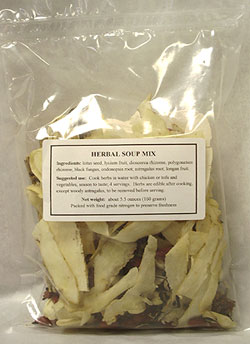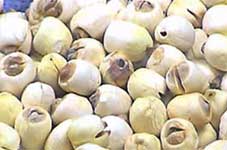
CHINESE HERBAL CHICKEN SOUP
One of the common ways to use tonic herbs in China is cooking them in the form of a soup along with chicken. This is because chicken is thought to bring out and enhance the tonifying and nourishing aspects of the herbs. Most of the tonic herbs have a pleasant taste that does not adversely affect the flavorful quality of mealtime soups made without the herbs. In fact, when properly selected, the additional herbs produce a highly desirable taste and texture for the soup. The following herb mixture for making chicken soup gets excellent reviews:
 astragalus | Lotus seed Lycium Dioscorea Polygonatum Black fungus Codonopsis Astragalus Longan |  lotus seed |
The root herbs-astragalus, codonopsis, and dioscorea-are classified by Chinese herbalists as qi tonics. They benefit digestion, aid absorption of nutrients, improve cardiac function, and enhance energy. The two dried fruits, lycium and longan, are classified as blood tonics; they are frequently used to treat anemia, reduce fidgeting, and benefit sleep. Black fungus is reputed to alleviate dryness and benefit the circulation; it adds a satisfying texture to the soup. Polygonatum is classified as a yin tonic; it helps restore moisture to dried membranes. Lotus seed is a mild tonic and sedative useful for alleviating nervousness and irritability.
To make the soup, place about 2 pounds of chicken (best with bones included) with the skin removed in a medium sized pot and add enough water to cover. Bring to a boil and remove any residue that floats to the top at that time. Add in the whole package of herbs, 2 cloves of crushed or grated garlic, 2 thin slices of fresh ginger, and a teaspoon of salt (the amount of garlic, ginger, and salt can be adjusted to your taste; these amounts are for a mild flavoring). Bring back to a slow boil, cover, and simmer for about 50-60 minutes.
Add sliced fresh vegetables, such as carrots and celery (for a more warming effect, use green onions), and various greens and squashes at this time and simmer again for an additional 5-10 minutes to soften them. Then add 1 tablespoon of soy sauce, 1 teaspoon of sesame oil, and 1 teaspoon of wine (or mild vinegar). Remove from heat. All the herb materials are edible except the astragalus, which is too fibrous, and this item should be removed before serving (it is the flat herb that retains a woody appearance).
The package of herbs contains about 5.5 ounces. This recipe makes enough soup for four servings (a large bowl of soup each) providing about 40 grams of dried herbs. For individuals recovering from serious illness or other debilitating experience, the soup can be taken daily for about one week to help restore strength. Others may wish to enjoy this dish about once a week for nourishing the blood and getting a great energy boost. Serve with a side dish of rice to make a complete meal.
Vegetarian Alternative: Cook the herbs together as above but without chicken; when adding the vegetables, also add one pound of tofu as a protein source. If desired; just before removing from heat, blend in four tablespoons of miso paste (or more to taste) in place of the tablespoon of soy sauce.
TRADITIONAL CHINESE CONCEPTS OF SOUP INGREDIENTS
Note: In the following text, the mention of organs, such as spleen and kidney, are in reference to the traditional descriptions as translated from the Chinese and do not imply any effect on the organs as recognized by modern medicine. Thus, for example, herbs that benefit the "spleen" are usually used to promote digestive functions, which are not related to the spleen functions as recognized today, and herbs that tonify the "kidney" are thought to adjust metabolism and have a variety of beneficial effects that are not associated with the function of the kidney as understood in modern medical terms. The descriptions of the therapeutic nature and applications in the traditional Chinese system are not intended to imply that all such benefits are provided by the soup.
- Chicken: its taste is sweet, its nature is warm, and it benefits the spleen and stomach. Chicken meat nourishes the qi and blood, and tonifies the kidney and essence. It is used therapeutically for blood deficiency, emaciation, and persistent illness; and for heart palpitations and dizziness. The vegetarian alternative tofu is cooling, lubricating, and benefits the spleen and stomach; miso is sweet and salty, its nature is neutral, and it benefits the stomach, spleen, and kidney. Miso and tofu are used to treat disharmony of the stomach, with loss of appetite, diarrhea, and abdominal discomfort.
- Garlic: its taste is pungent and sweet, its nature is warm, and it benefits the spleen, stomach, and lungs. It is used to promote digestion of foods, especially meats, to alleviate intestinal infections, and to treat coughing due to lung disorders.
- Carrot: its taste is sweet, its nature is neutral, and it benefits the spleen, liver, and lung. It is used for indigestion, weak vision, and cough with fever. Squashes, in general, are sweet, cooling in nature, and benefit the spleen, stomach, and lung. They are used for promoting urination and alleviating coughing.
- Celery: its taste is pungent and sweet, its nature is cool, and it benefits the liver, stomach, and bladder. It is used for feverish feeling, dizziness, agitation, loss of appetite, and difficult urination. Most green leafy vegetables are slightly astringent, cool, and benefit the spleen and liver.
- Green onion (scallion): its taste is pungent, its nature is warm, and it benefits the stomach and lungs. It is used for dispersing chill, relieving congestion, and relaxing muscle tension.
- Black fungus (wood ear): its taste is sweet, its nature is neutral, and it benefits the lung, stomach, and liver. It is used for dry cough, dry throat and mouth, and for other symptoms of dryness.
- Lotus seed: its taste is sweet and astringent, its nature is neutral, and it benefits the spleen, kidney, and heart. It is used for loss of appetite and diarrhea due to weak digestion, for frequent urination, and for restlessness.
- Lycium: its taste is sweet, its nature is neutral, and it benefits the liver and kidney. It is used for weakness due to overwork and aging, for weak vision, and for chronic cough.
- Longan: its taste is sweet, its nature is warm, and it benefits the heart and spleen. It is used for deficiency of blood, with poor memory, heart palpitations, and weakness.
- Astragalus: its taste is sweet, its nature is mildly warm, and it benefits the spleen and lung. It is used for all kinds of qi deficiency syndromes, especially when there is excessive sweating.
- Dioscorea: its taste is sweet, its nature is mildly warm, and it benefits the spleen, lung, and kidney. It is used for treatment of diarrhea and frequent urination.
- Codonopsis: its taste is sweet, its nature is mildly warm, and it benefits the lung and spleen. It is used for all types of qi deficiency syndromes, especially when there is weak digestion. It is commonly used by Chinese herbalists as a substitute for ginseng.
- Polygonatum: Its taste is sweet, its nature is mildly cold, and it benefits the lung and stomach. It is used for any kind of yin-deficiency syndrome, typically manifesting as fidgeting, dry mouth and throat, and dry cough.